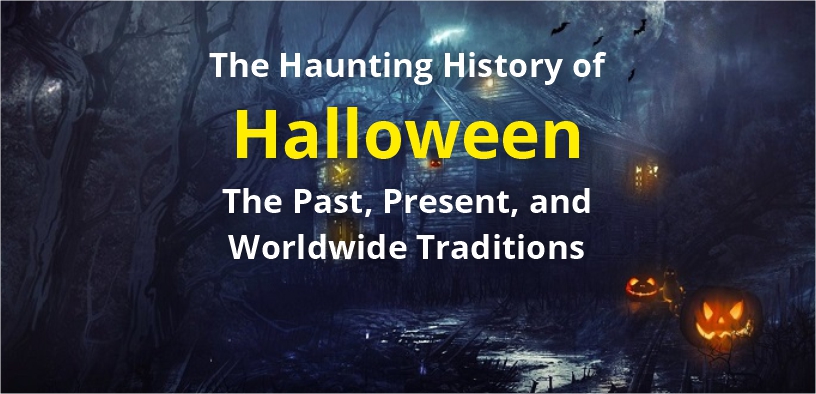Halloween, the beloved holiday of carved pumpkins, ghoulish costumes, and sweet treats, is celebrated globally. While it’s deeply entrenched in American culture, its origins extend far beyond the United States, tracing back more than a thousand years and covering various continents. This thrilling journey takes us from ancient Celtic traditions to modern-day Halloween, exploring the cultural evolution of this spooktacular celebration.
Ancient Origins: Samhain, the Celtic New Year
Halloween’s roots reach back to the ancient Celtic festival of Samhain, marking the end of summer and the onset of winter, a season linked with death. It was believed that on the night of October 31, the boundary between the living and the dead became thin, allowing spirits to roam freely. To ward off these otherworldly visitors, people dressed in animal skins lit bonfires and celebrated the harvest. Halloween’s ghostly themes, including witches and ghosts, found their beginnings in this ancient ritual.
Halloween’s Christian Transformation
The spread of Christianity led to the transformation of Samhain into a Christian holiday. All Saints Day, originally celebrated on May 13, was created by Pope Boniface IV in the 7th century. It was meant to honor Christian martyrs. In the 8th century, Pope Gregory III shifted the holiday to November 1, likely as a Christian alternative to Samhain. October 31, the evening before All Saints Day, became known as All Hallows’ Eve, or Halloween.
Migration to America: A Melting Cauldron of Traditions
Halloween’s journey continued when it arrived on American shores. The American colonial Halloween celebrations were limited, primarily due to the religious beliefs of the Puritans in New England. However, the Southern colonies embraced the holiday. As Irish and Scottish immigrants arrived in the 19th century, they brought their Halloween traditions and spiced up the American Halloween scene.
Trick-or-Treating: A Mix of Old and New
The custom of “trick-or-treating” has its origins in European traditions. Children would dress up and ask for food or money in exchange for jokes, poems, or tricks. In America, it gained popularity in the early 20th century, thanks to the Irish and Scottish communities, becoming one of Halloween’s iconic activities.
Halloween in the Modern Era: More Than Candy
Today, Halloween is one of the biggest holidays for candy sales in the United States, with an estimated expenditure of over $3 billion. The traditions have evolved, and Halloween parties and decorations have become increasingly elaborate. People celebrate with creative costumes, eerie makeup, and spooky home décor. Haunted houses, horror-themed theme parks, and parades, like the famous Halloween Horror Nights and the Macy’s Thanksgiving Day Parade, are integral parts of the festivities.
Halloween Around the World
Halloween has become popular worldwide, although it may not be as extravagant as in the United States. In Mexico, the Day of the Dead, or Dia de los Muertos, celebrated from October 31 to November 2, combines with Halloween, creating a unique fusion of traditions.
The Tradition of Treats and Tricks
Trick-or-treating, derived from the British tradition of ‘going a-souling,’ symbolizes the essence of Halloween. Children go from house to house, requesting treats, and have a backup plan to play tricks if their demands are not met. The excitement of dressing up, knocking on doors, and receiving a treasure trove of candies remains a cherished part of Halloween.
From Superstition to Fun: The Changing Face of Halloween
Halloween’s history is one of transformation, where superstitions and ancient rituals evolved into family-friendly fun. A pumpkin carved into a spooky face replaced the older tradition of carving turnips and potatoes. Fortune-telling became apple-bobbing and other games, and scary ghost stories were replaced with costume parties and parades.
The Universality of Halloween
In this melting pot of history and cultures, Halloween transcends borders, becoming a universal celebration. It’s a night when people dress up in various costumes, share sweets, and celebrate the spookiness of the season, all while acknowledging its deep-rooted history.
Halloween’s captivating journey through history takes us from the ancient Celtic festival of Samhain to the lively celebrations of today. As it spreads its wings globally, Halloween becomes a unique blend of traditions, uniting people in the joy of dressing up, sweet indulgences, and a nod to the past. While its origins may be rooted in the ancient, its spirit is firmly fixed in the present, bringing delight to people of all ages, from children asking for treats to adults reveling in creative costumes and décor. So, as the fall leaves rustle and the moon shines bright, it’s time to embrace the enchanting world of Halloween once more.








